BY LINCOLN ANDERSON | An outrageous “land grab” for the real estate industry. A blatant privatization of public space for the hospitality industry. A quality-of-life — and a health — nightmare for local residents. … And, on top of that, it’s all being done with zero community input or buy-in.
And, not to forget, potentially explosive propane tanks for outdoor heating — rules for which still aren’t even set — might wind up piled next to residents’ buildings.
Those were among the major reactions and fears voiced by residents — and also some Community Board 2 members — at a C.B. 2 committee meeting Tuesday night on the city’s plan to make the Open Restaurants program permanent.
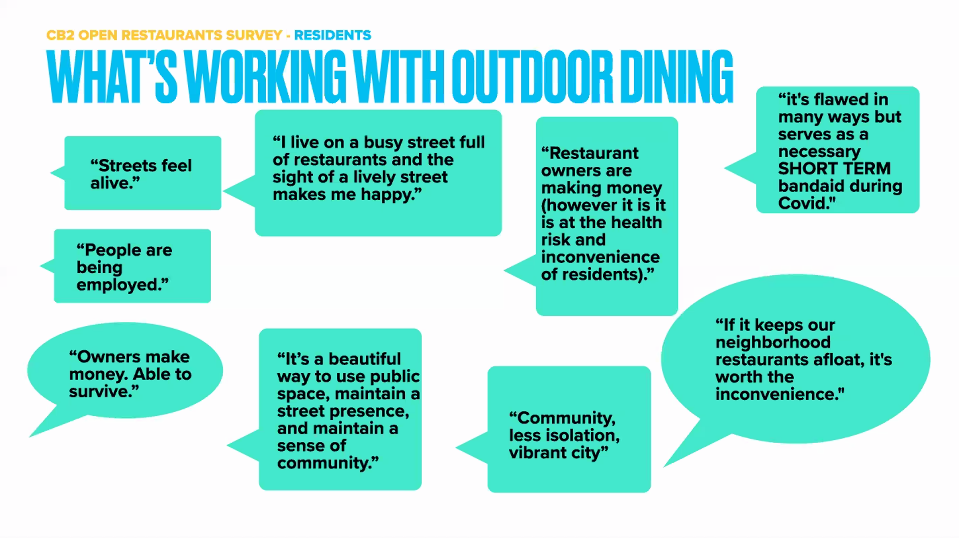
Mayor de Blasio put the Open Restaurants plan into place back in June to help struggling restaurants and bars weather the pandemic without indoor seating. The novel scheme allows these businesses — through a very streamlined application process — to have seating on their sidewalks, plus in the curbside lane in front of their places.
Then, on Sept. 25, the mayor unilaterally decreed that Open Restaurants would now be “permanent.”
If approved by the City Council, the roadway part of the plan is reportedly set to become permanent in October 2021. For the sidewalk cafe areas — seating and tables on the sidewalk next to the businesses — a permit process would still be required.
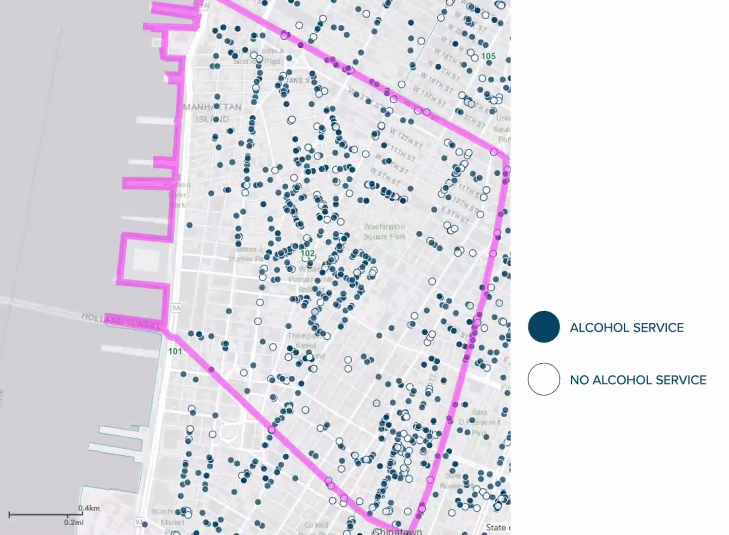
However, since the mayor cannot rule by fiat, the City Council is set to vote this Thursday on legislation to determine the future of Open Restaurants.
For its part, C.B. 2 recently conducted a survey of residents and operators on Open Restaurants, and on Tuesday night, its Reopening Working Group held the aforementioned meeting.
“The outdoor dining program has been an incredible success for businesses,” Carter Booth, the C.B. 2 chairperson, stated at the outset. “But with that success there have been some bumps in the road.”
The meeting focused mainly on the bumps.
In short, while many residents and committee members said they supported Open Restaurants to help restaurants and bars during the emergency health crisis, the idea of now making the outdoor seating permanent would be nothing short of a radical change for the district.
Booth noted that the city has only 1,800 businesses that are licensed for sidewalk cafes, but that there are currently 10,000 — or 5.5 times as many — participants in the popular Open Restaurants program.
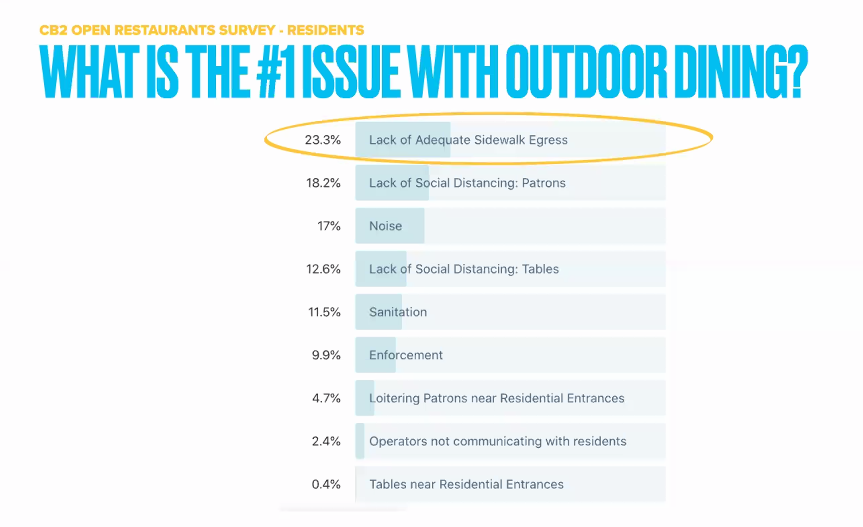
“The lack of public input on this is a huge issue for Community Board 2,” noted Valerie De La Rosa, the chairperson of the Reopening Working Group, “especially since we have the highest number of [liquor]-licensed premises.”
De La Rosa said that, according to the C.B. 2 survey, 893 businesses in the board district — which includes Greenwich Village, the West Village, Soho, Noho, Hudson Square, the Meatpacking District and Little Italy — are in the Open Restaurants program, including 706 that serve alcohol and 187 that don’t.
Both Booth, De La Rosa and others said a lack of enforcement of regulations for the Open Restaurant program is another major problem.
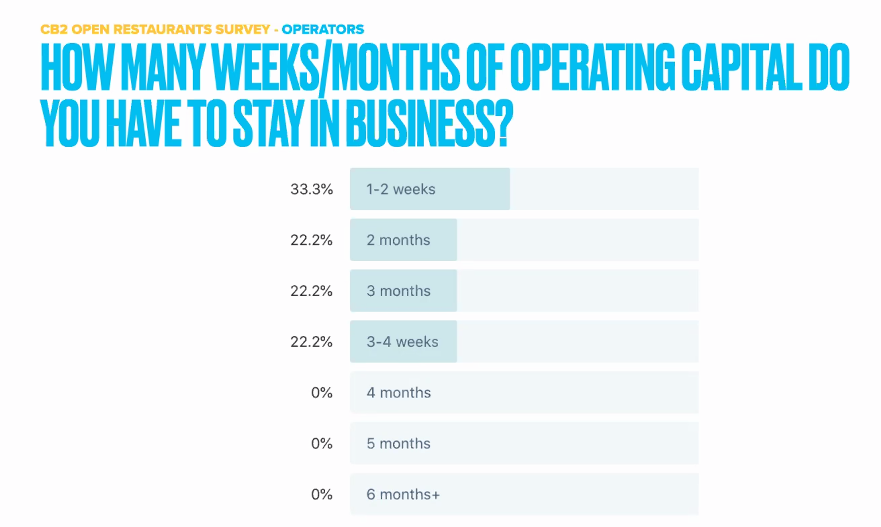
“[Residents] want to know, for a lot of these issues, is this going to be complaint-driven enforcement?” De La Rosa asked. Residents are “tired” of complaining and calling 311, she said. Sixty-four percent of residents responding to the survey wanted to know specifics on how the enforcement would work, she added.
On the positive said, some survey respondents liked the lively feel the outdoor seating has given the area, noting, “it feels like Paris, it feels like Europe,” the committee chairperson noted.
But that last sentiment and any other positive feelings about the pandemic-triggered plan were overridden at the meeting by residents’ anger and concern over Open Restaurants being pushed through as what they called a “fait accompli.”
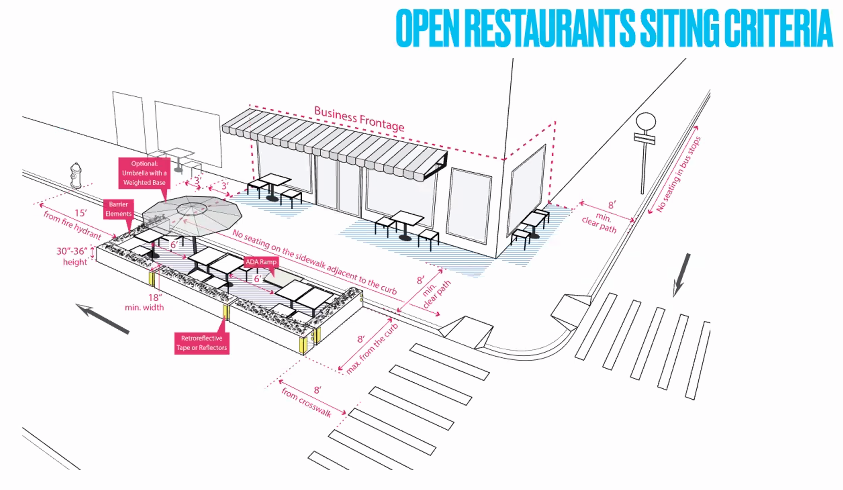
Meanwhile, to locals’ dismay and disbelief, decades worth of painstakingly hashed-out regulations and agreements between nightlife operators and residents — as well as carefully crafted city zoning — appear to be getting tossed right out the window.
The idea of “equity” was another issue — as in, is too much being handed to landlords and the nightlife industry.
Soho activist Pete Davies noted that landlords would see a windfall from the plan becoming set in stone.
“All of a sudden, any building with a restaurant becomes more valuable,” he said. “You gotta think about equity here.”
“Now it’s another year — and maybe forever,” Village resident Leslie Clark said of Open Restaurants. “They are talking about privatizing community public property. Where are we in this process? We are conveying into private hands public property to one industry only. What about other people?
“What are we going to do to restore citizen input to a process that is permanent?” Clark asked.
Clark and several other residents, calling themselves the West Village Residents Association, sent a detailed letter to C.B. 2 arguing why the plan needs to be better thought-out.
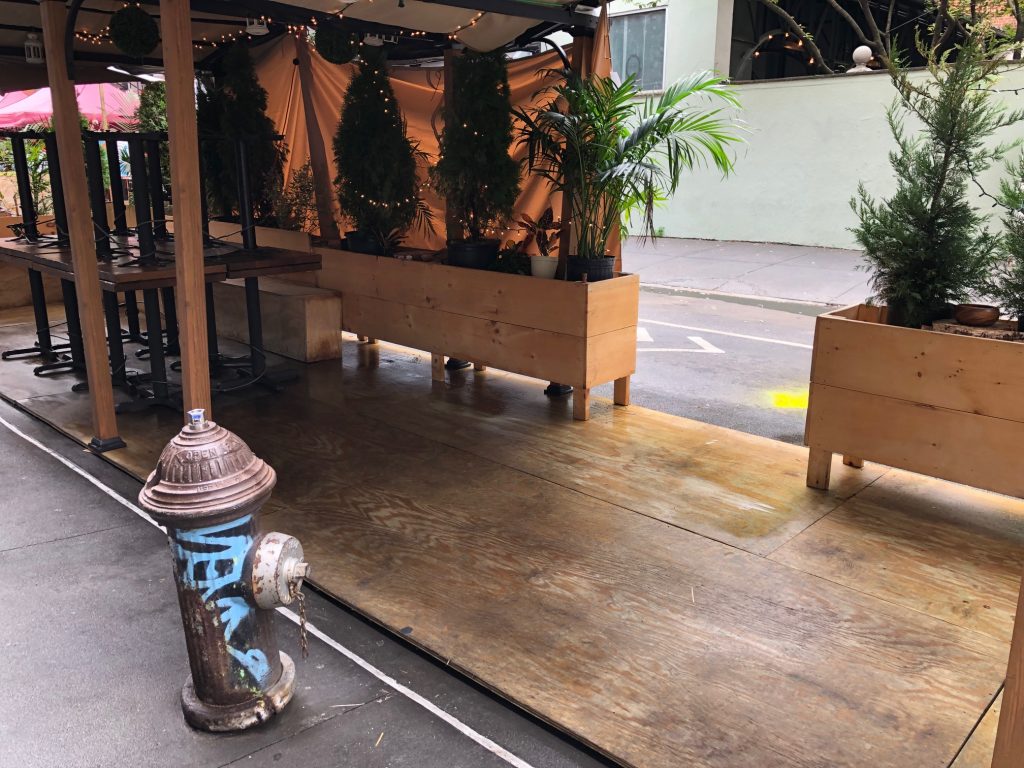
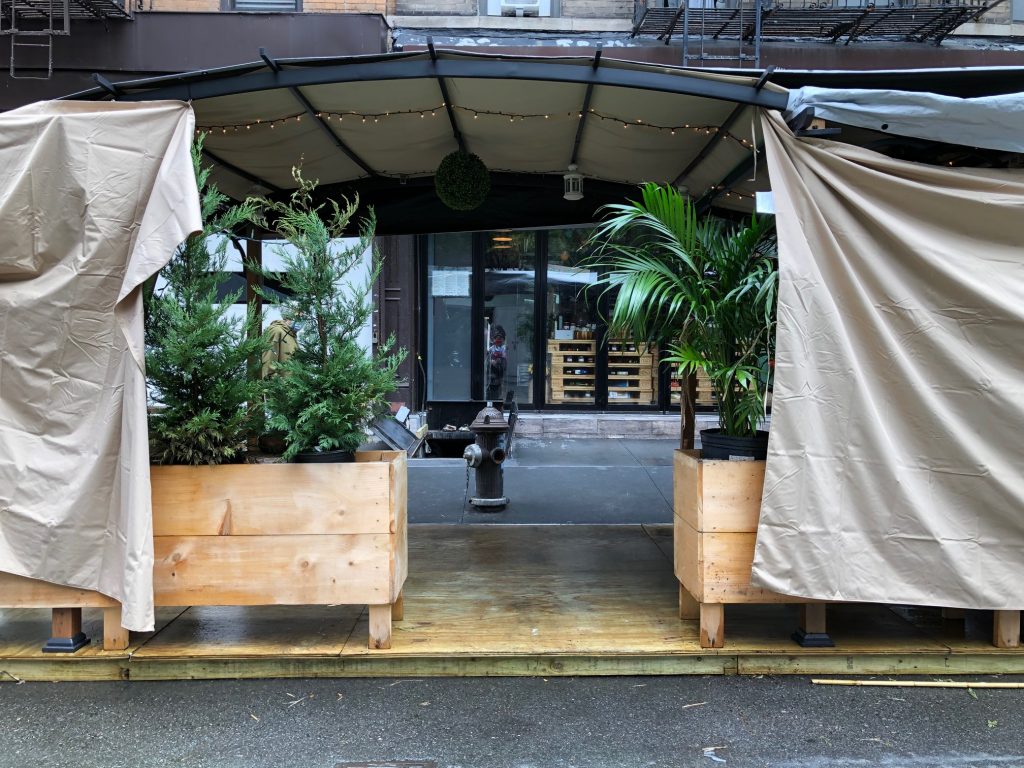
Like others at the meeting, Stuart Waldman, a longtime Bedford St. resident, was incredulous at the idea of Open Restaurants suddenly being here forever. He said there’s a reason areas with narrow streets, like his, don’t normally allow sidewalk cafes.
“I’m for it on a temporary basis,” he said of the emergency outdoor seating. “But the idea of making it permanent boggles the mind. Now we’re going to make permanent — to take that noise out of the inside and onto the street? Now every night it’s a party in my house,” he said of the noise the program is currently creating. “If you allow a business to be open on the street at night, how is that a residential neighborhood?”
Like others, Waldman criticized on environmental grounds the city allowing operators to have heaters for outdoor seating in the cold weather.
“Ten thousand heaters — the amount of carbon emissions is mind-boggling,” he said.
His wife, Livvie Mann, was equally stunned by the situation.
“I think this is a brazen move to usurp public property,” she said of Open Restaurants. “The idea of making it permanent — it hasn’t even been in place for the four seasons. It’s been in place for two months.”
Mann said she was distressed about having to walk past outdoor diners “coughing and yelling without masks.”
“As an older person, that’s unnerving,” she said.
“It was initially done because of a crisis,” she said. “Why make it permanent after the crisis is done?”
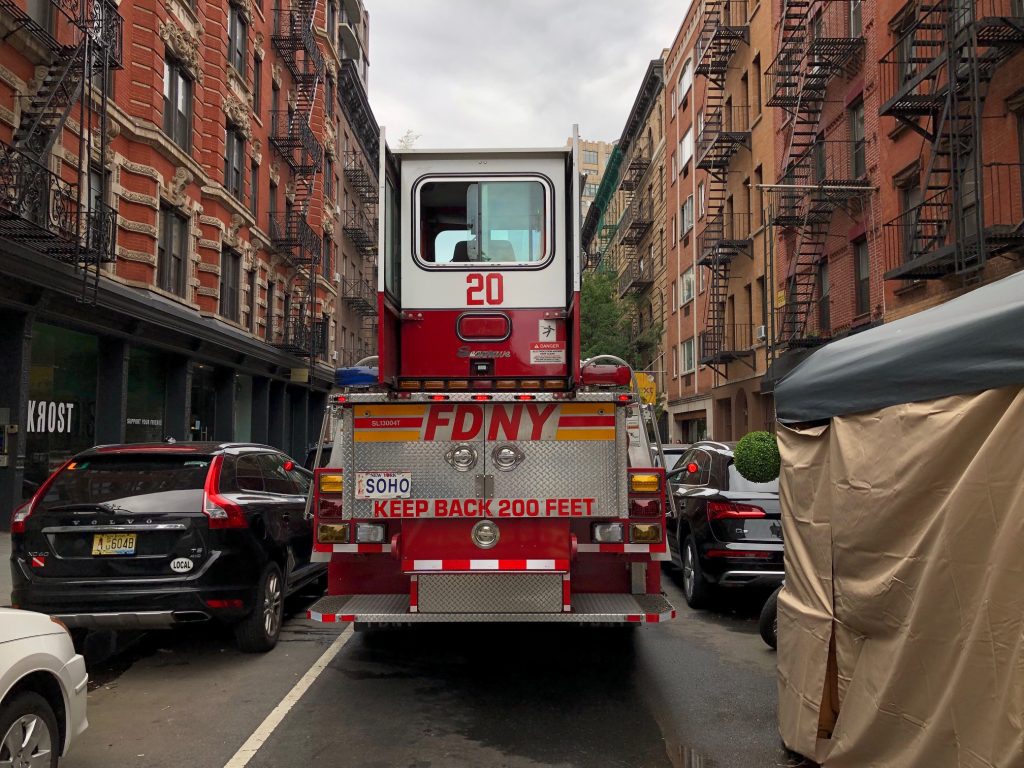
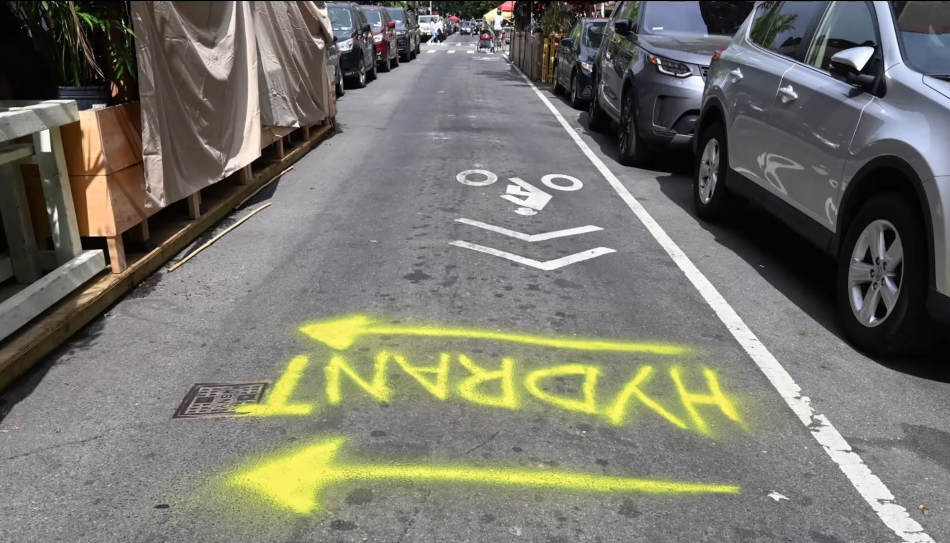
The couple noted all the negotiations over years and years that were hammered out to allow residents and businesses to coexist, such as stipulations for the businesses to keep their windows closed at night so that residents can have some peace and quiet.
“It’s all been blown out of the water,” Mann said, in shock, “decades of civic discourse.”
Similarly, Bob Ely, chairperson of one of the board’s Liquor Licensing committees, said C.B. 2 plays a vital role in getting operators to accept and abide by negotiated agreements with the community on things like hours of operation, music and outdoor seating — known as stipulations. In recent years, the State Liquor Authority has gotten much better at actually including and enforcing these agreements.
“It took decades to get the S.L.A. to impose stipulations [on operators],” he said. “The community board acts as an intermediary — it works.”
Andrew Kunkes, from the Mayor’s Office, where he is Manhattan borough deputy director, told the meeting that urgency trumped community input.
“There was a need to do this very quickly,” he said. “There was a need to truncate the public process.
“This is something that has been decided,” he stated of making Open Restaurants permanent. “We are moving forward on this. … This is an industry that makes New York City so unique and is such a draw.
However, Kunkes also said, “This is a work in progress. We will continue to fine-tune this.”
And he further added, “There’s still time for you to reach out to your city councilmember and urge them to oppose this.”
One resident said she found Council Speaker Corey Johnson to have been unresponsive to complaints on the issue.
Typing in the chat section at one point, Davies wrote, “We have a lot of LAME DUCKS making decisions that will last into the future when they are NO LONGER ACCOUNTABLE.”
To claims that the hospitality industry is being unfairly given open space, Kunkes countered that public schools are also being given open streets for outdoor learning.
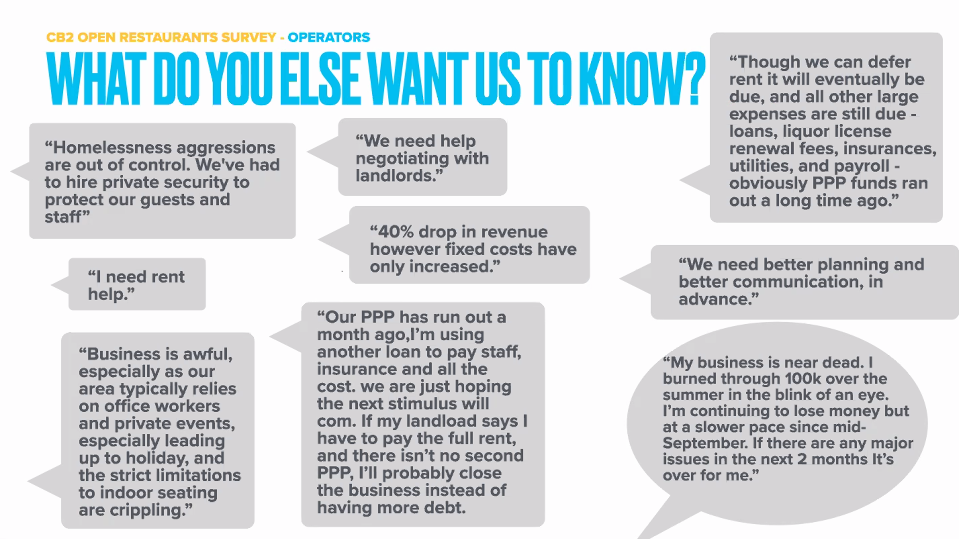
Another de Blasio administration representative at the meeting, Kyle Gorman, from the Department of Transportation, described himself as “the guy behind all of this.” D.O.T. is overseeing the Open Restaurants program.
However, Gorman didn’t exactly inspire confidence with his apparent lack of understanding of existing noise regulations governing bars and restaurants. Basically, Gorman claimed that “incidental music” is allowed for outdoor seating.
When he was challenged on that point by Booth, he deflected, “We’ll have to circle back.”
But Kunkes clarified, stating, “We are only allowing acoustic music.”
Kunkes admitted there have been reports of some bars and restaurants playing music inside “so it can be heard on the street — quite loud.”
Booth asked Gorman if it is not true that the S.L.A. regulates music for bars and restaurants.
“I think that we should just circle back,” Gorman repeated.
Posting in the chat section of the Zoom meeting, Davies typed emphatically, “The S.L.A. has clearly stated NO MUSIC audible outside… . S.L.A. Chairman Bradley is very clear on this topic.”
Zella Jones, a former C.B. 2 member who chaired the board’s Sidewalks Committee for several years, said D.O.T. has never had any connection to the S.L.A.
“They’re totally unprepared for managing street-side dining,” she scoffed of D.O.T. The outdoor program should be moved under the oversight of the Department of Consumer and Working Protection (formerly known as the Department of Consumer Affairs), she stressed.
“I feel as if Trump has won,” lamented Soho’s Lora Tenenbaum. “This is about real estate.”
On the subject of outdoor heaters, she noted that France passed a law against them due to the particulate matter they spew.
“We are a city that just passed a law about buildings being greener,” she said. “Now these heaters are going to be terrible.”
“We’re sitting on a powder keg,” added Gilda Pervin, referring to the heaters and their fuel. “We don’t want another Second Ave. explosion.”
The Fire Department is working on setting regulations for the heaters.
Another top complaint of residents was the lack of pedestrian space caused by operators violating sidewalk regulations. Micki McGee of Soho showed a slide-show presentation of restaurants that are not leaving 8 feet of space for pedestrians to pass by.
“We are being forced into the street,” she declared.
Residents also said the outdoor platforms, seating and crowds — plus street closures on some streets — also block access to their buildings.
Jeffrey Rowland noted that outside his apartment, the Italian restaurant Piccolo Cucina, at 75 Thompson St., has been a particularly bad operator, usually blocking a fire hydrant and not leaving the required 15 feet of space on either side of it.
“We’ve filed 311 complaints about social distancing violations and blocking the hydrant — and no response,” he said. “The city places a higher value on this business than on the residents.”
Augustine Hope noted that, before the pandemic, bars already had been supplanting other kinds of businesses because they can pay higher rents. That trend will only be exacerbated if Open Restaurants becomes permanent, he warned.
“What the mayor is doing is going to hyper-inflate rents in our neighborhood,” he predicted.
He also noted that, according to New York City government data, noise complaints citywide doubled — up to around 256,000 — in 2020 versus 2019.
Open Restaurants is leading to open flies, unfortunately, too, according to Joshua Spodek.
“I’ve been here since the ’80s,” he said, “I’ve never seen so much public urination.”
Reiterating people’s biggest concern, Booth said, “The issue is the word ‘permanent.’ People are O.K. with another year [of this] — but beyond that?”
Kunkes didn’t clarify as to the program’s permanence, but said he would look forward to “continuing these conversations” with Booth, De La Rosa and Liquor Licensing Committee co-chairperson Ely.
For his part, Gorman of D.O.T. cryptically referred to Open Restaurants as “a long-term program.”
Only one restaurant operator attended the meeting, posting in the chat section toward the end. C.B. 2 members said they recognized the meeting was happening during busy dining hours.

After the public comment session ended, committee members continued the discussion among themselves and deliberated on sending a letter to City Hall. Cormac Flynn, a C.B. 2 member who lives on W. Eighth St., painted a vivid picture of what he and his neighbors have been dealing with.
“I live in the apartment I was brought home to after I was born,” said Flynn, 54, “and I can say noise has never been worse. There was the motorcycle noise 15 years ago, but that was short bursts.”
Musicians now fill the street on weekend nights playing for the outdoor diners, impacting the lives of residents living in low-rise buildings, he said.
“I got brass quintets, I got amplified jazz singers, I got strolling buskers,” Flynn said. “Apparently, it’s against the rules, but there’s no enforcement.”
He said the only enforcement on noise or other conditions stemming from the outdoor program is by the Village Alliance business improvement district. No one else wants to do anything about it, he said.
Some nights, due to the din, he related, “You will find me sitting in the back of my apartment in my kitchen or bathroom reading because I cannot watch television or work on my computer.
“I’m willing to work around it — but as a permanent thing?” he said of the disruptive dining program. “That is a permanent impact on my quality of life.”
Flynn noted his block of W. Eighth St. is part of a specially zoned district that specifically bans sidewalk cafes. To ensure that prohibition was never lifted, when the street’s sidewalks were widened back in the early 2000s, they were kept 6 inches too narrow to legally allow sidewalk cafes, he said.
Like others, he lamented the obliteration of hard-won, long-established protections.
“These things were worked out over decades,” Flynn said, “with residents, real estate, Community Board 2. Then with a stroke — all gone. What does that say about democracy?
“This is the most transformative thing for Greenwich Village since Robert Moses proposed the Lower Manhattan Expressway,” he added. “To push it through now — to rush through this wholesale dramatic change that would transform our community without input — I’m sorry, but that’s just corrupt.”

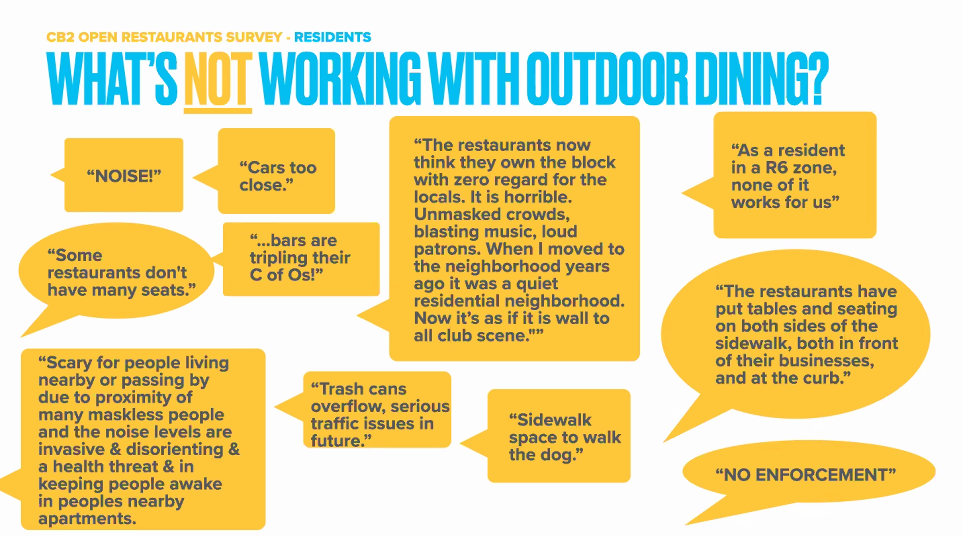
Oh, and please stop putting pedestrians and bicyclists in the same category!!! Bikes follow rules of the road. They are NOT the same demographic or use the streets in the same way!
Remember, pedestrians and bicyclists are not just 20 and 30 somethings. We have a large population of older residents and seniors who require safe sidewalk passage. They are using slower steps, walkers, canes, shopping carts, and are pandemic prudently avoiding crowds — so those outdoor dining gauntlets are a new and unnecessary burden! Again, it’s not just about you… that’s the motto of 2020.
And to respond to a post above: We’re not NIMBYs – we are considering the needs of ALL the neighbors of our community!
Thoughts:
Not only are “lively” streets a noise and egress issue – this is implying folks are gathering — and unmasked since eating and drinking necessitate this. So, unmasked gathering in a pandemic — how is that a good thing? And these elaborate structures are now in essence “indoor seating” with walls — a contradiction to the whole point of outdoor dining, which is better than indoor air circulation because it’s…outside…(i.e. no walls / shared air).
Open Streets barricades are placed incorrectly — they are supposed to be angled and have constant egress — you are not supposed to have to get out of your vehicle to pass through them. Instead, I see them placed across a road, completely shutting off vehicle traffic requiring firetrucks and other emergency vehicles to STOP and move the barricade for passage. Huh? Every second counts, folks. That could be you, your family, or your home in need of emergency services.
Reminder: everyone walking or biking to the restaurants for outdoor dining can get take out or delivery and tip generously. The restaurants get your money, you get restaurant food, and this limits not only sidewalk risks noted here but also limits risk to the restaurant staff. No, it’s not the same, but what in 2020 is? These are rough times and the community needs to come together — like in WW2, it’s not about “you” but about lifting up your neighborhood. Bring the food home, buy an extra meal for tomorrow, and heat it all up in your residence. Win win!
Interesting that about 90% of the positive comments FOR extended outdoor dining are that the streets are more LIVELY.
The hell with public lively! TELL THAT TO PEOPLE WHO LIVE ABOVE AND NEAR LIVELY!!
Amazing to hear this NIMBY attitude from CB2 residents (and board members) regarding open streets. Where was your sanctimony as we continued to give over our streets to another (far more destructive) private enterprise – the car?!?
Get real for a minute here – cars have decimated our economy, our health, and our quality of life to a degree only rivaled by cigarettes. If we remove cars as we did cigarettes, we will reap huge economic and health benefits IMMEDIATELY. You have a duty to your fellow citizens to protect the public health and a fiduciary responsibility (if you serve on a board) that requires that you support open streets, as they have been proven over the course of decades in cities across the globe to successfully promote economic development.
Replacing cars with vibrant economic activity that meets a demand of the public should be a simple equation. Restaurants (and other businesses) sweep the streets, maintain civic order, decorate, AND SERVE LIFE-SUSTAINING FOOD while the air quality improves, public health improves, noise pollution drops, while generating tax revenue and creating jobs. Cars, like cigarettes, can’t do that.
Once cars are repurposed in the design of our streets, we do not have to make a false choice between cafe culture and pedestrian safety. Cafe’s can have the contiguous space in front of their businesses, and pedestrians can safely share the street with cyclists.
I say this as a long-time Manhattan restaurateur, father of a young child, and son of aging parents. Please get off your NIMBY high horse and think about what you are saying – you are prioritizing an antiquated technology (cars) over the public health and welfare.
Issues arising out of the success of the Open Streets and Open Restaurant programs can easily be resolved with design and education. Legislation and enforcement should be held in reserve for later. The noise pollution of a sidewalk cafe is much less than that of car traffic.
If you value civil society, public and economic health, you would be well served to get behind the sort of changes to the public health prescribed by the Mass Design Group’s Spatial Strategies for Restaurants in Response to COVID-19 – https://massdesigngroup.org/sites/default/files/multiple-file/2020-05/Spatial%20Strategies%20for%20Restaurants%20in%20Response%20to%20COVID-19_.pdf. They have been working on pandemic responses for over two decades in Africa and Haiti. The time for knee jerk responses is over, and it is time to educate ourselves on the basics of modern urbanist thinking. Let go of the internal combustion engine, and embrace the power of hospitality in the public sphere. “In responding to the pandemic, restaurants can and must play a central role in our redesigned public realm.” (see above from Mass Design Group)
I love all the neighborhoods of CB2, but The Village Sun readers, and those who gave testimony should educate yourselves before you pontificate. Lives (and quality of life) are at stake.
It seems like an overreaction by a bunch of spoilsports to something beautiful and positive during a pandemic, one of de Blasio’s best initiatives. Power to the working people in outdoor dining who benefit from this program and to the residents who enjoy new life on the streets, complete with music.
My guess is that you don’t live near one…and that you’ve got some connection to the restaurant industry.
This so called survey is entirely biased towards complaints and problems. Cancelling the Sun subscription. Propaganda, not reporting.
You are an idiot…with your head in the sand.
White Horse Tavern moved their seating in the street to enclosed seating on the Hudson Street sidewalk. Today I saw construction of more enclosed seating on West 11th. This is more than they ever had indoors.
OMG! This is horrendous. The sidewalks and street belong to the PEOPLE, NOT the landlords or restaurant owners.
I live in SoHo and am 100% against this…the noise, the limited access, the GARBAGE, the smells, the danger of propane leaks and explosions. COVID is still here and growing…many places are still not obeying rules.
Not to mention the OTHER land grab the Soho/Noho rezoning!